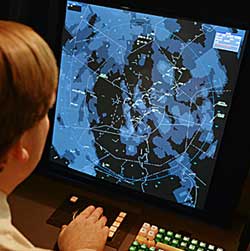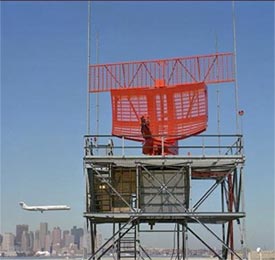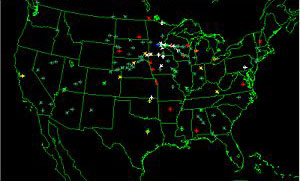Air Traffic Control and Radar: Difference between revisions
No edit summary |
No edit summary |
||
| Line 37: | Line 37: | ||
[[Category:Control_systems]] | [[Category:Control_systems]] | ||
[[Category:Environment,_geoscience_&_remote_sensing]] | [[Category:Environment,_geoscience_&_remote_sensing]] | ||
[[Category:Radar]] | [[Category:Radar]] | ||
Revision as of 17:44, 21 April 2014
Air Traffic Control and Radar
Every day tens of thousands of people board airplanes to travel from one place to another. These flights, thousands of which take off and land daily, are among the safest forms of travel. Although airplane crashes are tragic and headline grabbing, the fact is the sky is a very safe place to be. But how, with so many airplanes in the air, does air travel maintain such a good safety record? The answer is, in large part, air traffic control, the complex system of directing planes and telling them how high or low to fly, and when and where to land safely.
Air traffic control systems rely heavily on radar. Radar first made a huge impact during World War II when it was largely developed for use by battling nations. After the war the civil (that is, non-military) aviation community began to apply radar techniques developed during the war to civil aviation guidance and surveillance. The first use of this technology involved using radar to aid landing.
In 1943 U.S Air Force air traffic controllers began routinely using Ground Controlled Approach (GCA) equipment to help military pilots land safely in poor visibility. GCA employed a pair of oscillating radar antennas with narrow “pencil beams,” one scanning side to side (azimuth), the other up and down (elevation). A controller observed the precise angle returns from these azimuth and elevation radars and radioed landing guidance to the pilot. GCA also included a 360-degree rotating radar for surveillance of the entire terminal area. This radar used a “fan” beam (narrow in azimuth and tall in elevation) that detected planes out to about 20 miles from the airport and up to altitudes of about 3000 meters (10,000 feet).
Civil controllers first used military GCA equipment at LaGuardia Airport in 1945, where it helped triple the landing rate to 15 planes per hour. GCA experienced occasional problems, but it worked well enough so that by 1952 it was being used at many airports. By the mid-1950s, however, GCA landing guidance components were being replaced by a new landing aid called the Instrument Landing System (ILS). ILS uses similar course guidance principles, but uses receivers in aircraft that display course deviation directly to the cockpit.
While it’s crucial that planes land safely, it is equally important that they be safe during flight. Thus, as ILS replaced the GCA scanning pencil beams, improved rotating radars with faster scan rates and larger coverage areas also replaced the GCA terminal area surveillance radars. As air traffic continued to grow it also became important to track planes in high-altitude airspace. Accordingly, the coverage of air traffic radar surveillance grew throughout the 1960s as long-range radars were deployed along important air routes. Initially, these aircraft surveillance radars had no automatic tracking capability. Controllers pushed plastic markers called “shrimp boats” around the screen to track the movement of an aircraft. By the 1960s radar surveillance of civil aircraft routinely included automatic aircraft tracking. Air traffic control radars now track both aircraft and hazardous weather. Modern air traffic control radars use the Doppler effect to discriminate moving aircraft from stationary targets and to measure storm velocities.
Another system developed during World War II, and which had great impact on civil aviation, was the Identification Friend or Foe (IFF) system. IFF depended on special radar receiver/transmitter units located in friendly aircraft. These radar “transponders” responded to coded radar “interrogations” with coded replies to indicate that they were not hostile aircraft.
In the late 1950s it was proposed that IFF technology be used for surveillance of civil aircraft. The use of transponders increases the detection range of the radar, eliminates clutter interference from other reflectors, and provides a means of aircraft identification and altitude reporting. In the early 1960s the U.S Federal Aviation Administration (FAA) published a national standard for air traffic control interrogators and transponders. By the end of the decade over 200 ground-based interrogators were in use in the U. S and the FAA made it mandatory to equip aircraft with transponders before they could operate in positive controlled airspace at high altitudes and near major airports.
In the 1970s the FAA enlisted the aid of the MIT Lincoln Laboratory to upgrade the original air traffic control radar beacon system to improve its surveillance performance in dense airspace and to expand its coded transmissions to transmit air traffic control data between the ground and individual aircraft. This “discrete addressed” beacon system uses ground sensors and airborne transponders that are interoperable with the original beacon system, but which achieve surveillance accuracy, capacity, and reliability that is adequate to support automatic safety warning functions for controllers and pilots.
In the 1980s the FAA developed an airborne collision avoidance system based on air-to-air surveillance of the same air traffic control transponders used for surveillance from the ground. Today the use of this collision avoidance system is required on all air carrier aircraft operating in the United States and Europe.
The last part of the air traffic control system to benefit from radar surveillance was the airport runways and taxi-ways. Radar surveillance to assure safety of aircraft on the airport surface is difficult because of reflections from the ground and from airport structures and service vehicles. Although several generations of airport surface detection radars have been deployed since the 1990s, and surface surveillance performance has improved, reflections continue to cause unreliable tracking.
As with other radar environments, surveillance quality on the airport surface can be improved by the use of transponders. Unfortunately, the resolution of the beacon system used for airspace surveillance is inadequate to distinguish between closely spaced aircraft at airports. However, high-resolution surface surveillance can be achieved with multiple receivers on the airport surface that estimate transponder locations by comparing arrival times of replies from conventional transponders. Systems that combine this “multilateration” technique with primary radar surveillance can now achieve surveillance accuracies and reliabilities that are good enough to input to automatic safety warning devices on the airport surface.
Related recommended reading
The story of the invention of the Klystron.
This site is made possible by donations. If you find these articles valuable, please consider supporting the IEEE History Center’s work by making a donation to IEEE Foundation - History Center Fund. There is a box marked “Designations” with an arrow which allows you to assign your gift to the History Center.


